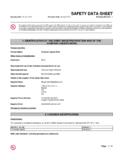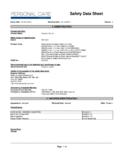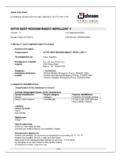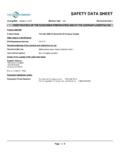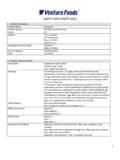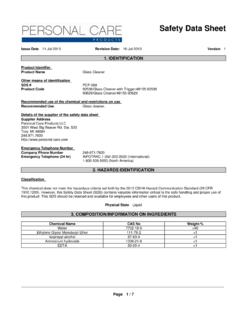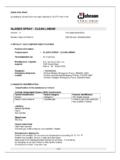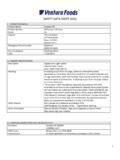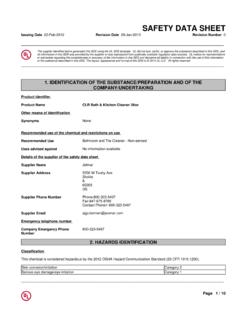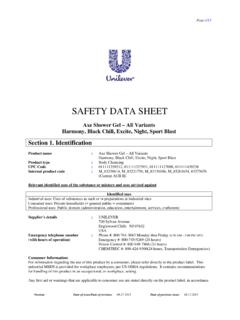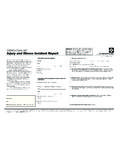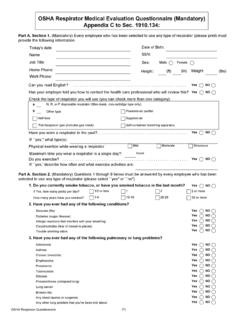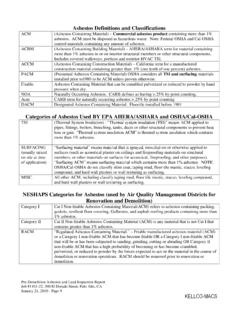Transcription of Conforms to USDOL OSHA 29CFR 1910.1200 …
1 Conforms to USDOL osha 29 CFR HAZCOM. SAFETY DATA SHEET. Lysol Brand III Disinfectant Spray, All Scents 1. Product and company identification Product name : Lysol Brand III Disinfectant Spray, All Scents Distributed by : Reckitt Benckiser LLC. Morris Corporate Center IV. 399 Interpace Parkway ( Box 225). Parsippany, New Jersey 07054-0225. +1 973 404 2600. Emergency telephone : 1-800-338-6167. number (Medical). Emergency telephone : 1-800-424-9300 ( & Canada) CHEMTREC. number (Transport) Outside and Canada (North America), call Chemtrec:703-527-3887. Website: : Product use : Disinfectant. This SDS is designed for workplace employees, emergency personnel and for other conditions and situations where there is greater potential for large-scale or prolonged exposure, in accordance with the requirements of USDOL Occupational Safety and Health Administration. This SDS is not applicable for consumer use of our products. For consumer use, all precautionary and first aid language is provided on the product label in accordance with the applicable government regulations, and shown in Section 15 of this SDS.
2 SDS # : D0224478 Formulation #: : 1338-022 (0175933 ) Original 1338-022 (8083521 ) Original 1338-019 (0175919 ) Country 1338-019 (8080039 ) Campestre 1338-016 (0175935 ) Summer Breeze 1338-018 (0175934 ) Green Apple / Green Apple Breeze 1338-017 (0175927 ) Kitchen (Citrus). 1338-021 (0175938 ) Crisp Berry 1338-020 (0175932 ) Garden Mist 1338-020 (8089468 ) Bebe 1338-015 (0175918 ) Spring Waterfall 1338-015 (0258756 ) Blr Swf Ext Prd 1178-172 (0175917 ) Crisp Linen 1178-172 (8089462 ) Frescura 1178-172 (0242193 ) Blr C/L Ext Prd 1338-026 (0175929 ) Early Morning Breeze 1314-032 (0175926 ) Citrus Meadows 1544-074 (0175943 ) Vanilla & Blossoms 1314-038 (0175920 ) Jasmine & Rain / Lavender e0002-161 (8159483 ) Pomegranate Crush 1784-045A (0346500 ) Crisp Mountain Air 1325-133 (0222651 ) Amphyl 1338-023 (0175940 ) Fresh / Oxygen EPA ID No. : 777-99. Code # : D0224478_US GHS SDS # : D0224478 Date of issue : 26/06/2015. 1/14. Conforms to USDOL osha 29 CFR HAZCOM. D0224478 1. Product and company identification UPC Code / Sizes : Sizes: 6 oz.
3 , 12 oz., oz. and 19 oz. (Tin plate steel cans). 2. Hazards identification Classification of the : FLAMMABLE AEROSOLS - Category 2. substance or mixture GHS label elements Hazard pictograms : Signal word : Warning Hazard statements : Flammable aerosol. Pressurized container: may burst if heated. Precautionary statements General : Keep out of reach of children. If medical advice is needed, have product container or label at hand. Prevention : Wear eye or face protection. Keep away from heat, sparks, open flames and hot surfaces. - No smoking. Pressurized container: may burst if heated. Do not pierce or burn, even after use. Do not spray on an open flame or other ignition source. Wash hands thoroughly after handling. Response : Not applicable. Storage : Protect from sunlight. Do not expose to temperatures exceeding 50 C/122 F. Disposal : Not applicable. Supplemental label : None known. elements Hazards not otherwise : None known. classified 3. Composition/information on ingredients Substance/mixture : Mixture Ingredient name % CAS number Ethyl alcohol 30 - 60 64-17-5.
4 Butane 1-5 106-97-8. propane < 74-98-6. Any concentration shown as a range is to protect confidentiality or is due to batch variation. There are no additional ingredients present which, within the current knowledge of the supplier and in the concentrations applicable, are classified as hazardous to health or the environment and hence require reporting in this section. Code # : D0224478_US GHS SDS # : D0224478 Date of issue : 26/06/2015. 2/14. Conforms to USDOL osha 29 CFR HAZCOM. D0224478 4. First aid measures Description of necessary first aid measures Eye contact : Immediately flush eyes with plenty of water, occasionally lifting the upper and lower eyelids. Check for and remove any contact lenses. Continue to rinse for at least 10. minutes. Get medical attention if irritation occurs. Inhalation : Remove victim to fresh air and keep at rest in a position comfortable for breathing. If not breathing, if breathing is irregular or if respiratory arrest occurs, provide artificial respiration or oxygen by trained personnel.
5 It may be dangerous to the person providing aid to give mouth-to-mouth resuscitation. Get medical attention if adverse health effects persist or are severe. If unconscious, place in recovery position and get medical attention immediately. Maintain an open airway. Loosen tight clothing such as a collar, tie, belt or waistband. Skin contact : Flush contaminated skin with plenty of water. Remove contaminated clothing and shoes. Get medical attention if symptoms occur. Wash clothing before reuse. Clean shoes thoroughly before reuse. Ingestion : Wash out mouth with water. Remove dentures if any. Remove victim to fresh air and keep at rest in a position comfortable for breathing. If material has been swallowed and the exposed person is conscious, give small quantities of water to drink. Stop if the exposed person feels sick as vomiting may be dangerous. Do not induce vomiting unless directed to do so by medical personnel. If vomiting occurs, the head should be kept low so that vomit does not enter the lungs.
6 Get medical attention if adverse health effects persist or are severe. Never give anything by mouth to an unconscious person. If unconscious, place in recovery position and get medical attention immediately. Maintain an open airway. Loosen tight clothing such as a collar, tie, belt or waistband. Most important symptoms/effects, acute and delayed Potential acute health effects Eye contact : May cause eye irritation upon direct contact with eyes. Inhalation : No known significant effects or critical hazards. Skin contact : No known significant effects or critical hazards. Ingestion : No known significant effects or critical hazards. Over-exposure signs/symptoms Eye contact : Adverse symptoms may include the following: irritation redness Inhalation : Adverse symptoms may include the following: respiratory tract irritation coughing Skin contact : No specific data. Ingestion : No specific data. Indication of immediate medical attention and special treatment needed, if necessary Notes to physician : Treat symptomatically.
7 Contact poison treatment specialist immediately if large quantities have been ingested or inhaled. Specific treatments : No specific treatment. Protection of first-aiders : No action shall be taken involving any personal risk or without suitable training. It may be dangerous to the person providing aid to give mouth-to-mouth resuscitation. See toxicological information (Section 11). Code # : D0224478_US GHS SDS # : D0224478 Date of issue : 26/06/2015. 3/14. Conforms to USDOL osha 29 CFR HAZCOM. D0224478 5. Fire-fighting measures Extinguishing media Suitable extinguishing : Use an extinguishing agent suitable for the surrounding fire. media Unsuitable extinguishing : None known. media Specific hazards arising : Flammable aerosol. In a fire or if heated, a pressure increase will occur and the from the chemical container may burst, with the risk of a subsequent explosion. Gas may accumulate in low or confined areas or travel a considerable distance to a source of ignition and flash back, causing fire or explosion.
8 Bursting aerosol containers may be propelled from a fire at high speed. Runoff to sewer may create fire or explosion hazard. Hazardous thermal : Decomposition products may include the following materials: decomposition products carbon dioxide carbon monoxide Special protective actions : Promptly isolate the scene by removing all persons from the vicinity of the incident if for fire-fighters there is a fire. No action shall be taken involving any personal risk or without suitable training. Move containers from fire area if this can be done without risk. Use water spray to keep fire-exposed containers cool. Special protective : Fire-fighters should wear appropriate protective equipment and self-contained breathing equipment for fire-fighters apparatus (SCBA) with a full face-piece operated in positive pressure mode. 6. Accidental release measures Personal precautions, protective equipment and emergency procedures For non-emergency : No action shall be taken involving any personal risk or without suitable training.
9 Personnel Evacuate surrounding areas. Keep unnecessary and unprotected personnel from entering. In the case of aerosols being ruptured, care should be taken due to the rapid escape of the pressurized contents and propellant. If a large number of containers are ruptured, treat as a bulk material spillage according to the instructions in the clean-up section. Do not touch or walk through spilled material. Shut off all ignition sources. No flares, smoking or flames in hazard area. Avoid breathing vapor or mist. Provide adequate ventilation. Wear appropriate respirator when ventilation is inadequate. Put on appropriate personal protective equipment. For emergency responders : If specialised clothing is required to deal with the spillage, take note of any information in Section 8 on suitable and unsuitable materials. See also the information in "For non- emergency personnel". Environmental precautions : Avoid dispersal of spilled material and runoff and contact with soil, waterways, drains and sewers.
10 Inform the relevant authorities if the product has caused environmental pollution (sewers, waterways, soil or air). Methods and materials for containment and cleaning up Small spill : Stop leak if without risk. Move containers from spill area. Use spark-proof tools and explosion-proof equipment. Dilute with water and mop up if water-soluble. Alternatively, or if water-insoluble, absorb with an inert dry material and place in an appropriate waste disposal container. Dispose of via a licensed waste disposal contractor. Code # : D0224478_US GHS SDS # : D0224478 Date of issue : 26/06/2015. 4/14. Conforms to USDOL osha 29 CFR HAZCOM. D0224478 6. Accidental release measures Large spill : Stop leak if without risk. Move containers from spill area. Use spark-proof tools and explosion-proof equipment. Approach release from upwind. Prevent entry into sewers, water courses, basements or confined areas. Wash spillages into an effluent treatment plant or proceed as follows. Contain and collect spillage with non-combustible, absorbent material sand, earth, vermiculite or diatomaceous earth and place in container for disposal according to local regulations (see Section 13).
